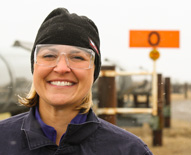CTE Programs Help Prepare All Students for Success
GUEST COLUMN
By Heidi Drygas, Commissioner, Alaska Department of Labor and Workforce Development
There is no institution that is more important for a state’s economic prosperity than its public school system. Thank you to the school board members and educators who have travelled to Juneau and contacted your legislators in support of a sustainable fiscal plan. Without a plan, our schools will suffer and teacher layoffs will accelerate. In contrast, with a sustainable fiscal plan we can adjust successfully to new economic realities and ensure that many more generations of Alaskans live in a vibrant and prosperous state.
You may be wondering, “Why is the Commissioner of Labor and Workforce Development writing a guest column in a school board newsletter?” The answer is simple: we must ensure that our secondary and post-secondary education systems prepare all students for success, and not just the minority of students who easily transition to traditional four year degree programs.
Here is the plain truth: one in four students sitting in Alaska high school classrooms today will go on to graduate from college. The vast majority of Alaska’s students will not go on to earn a college degree. It is the state and local schools’ responsibility to help the other 75% of students plan for successful post-secondary education, training, and careers.
We know that comprehensive career and education planning works: consider how countries like Germany and Switzerland have used apprenticeship and other career and technical education (CTE) programs to achieve youth unemployment rates that are half those of the United States, without any sacrifice in educational rigor or expectations of students. Working together, we can achieve similar positive outcomes for students, workers, and for the state of Alaska.
I want to thank Commissioner Michael Johnson of the Department of Education & Early Development, and the many CTE professionals who work with our department to expand CTE programs, including superintendents and staff from the Anchorage, Juneau, Fairbanks North Star, North Slope, Lower Kuskokwim, Mat-Su, and other school districts. We are working together to expand school-to-apprenticeship programs. Many students are hands-on learners, no less skilled or intelligent but in need of a different instructional style than is offered in a traditional four-year college setting. Other students can’t afford NOT to work. One of the reasons that Alaska and America are lagging in post-secondary achievement is that many students can’t afford not to work after high school—sure they can take out student loans, but what pays for rent and puts food on the table? For these students, apprenticeship can be a great fit.
Students, who are also working, earn a wage while they work toward a nationally-recognized Registered Apprenticeship credential, which indicates proficiency in their occupation. In some cases, the apprenticeship can be concurrent with college credit—University of Alaska Anchorage does this in partnership with a Subaru mechanic apprenticeship, and ANTHC is rolling out an exciting new Behavioral Health Aide apprenticeship that has concurrent college credit. We need more of these programs, and we need more high school CTE programs to link directly to existing apprenticeships.
Our efforts to strengthen CTE, including apprenticeship, is part of the statewide “65 by 2025” campaign to increase post-secondary graduation and certificate credentials. We’re moving beyond the old paradigm of either college or job training, because we need both in order to achieve the state’s education and workforce development objectives.
If you would like to work with my department to explore expansion of school-to-apprenticeship programs in your district and community, please let me know by dropping me an email. Thank you again to all the school board members and school district staff who are working to strengthen CTE and school to apprenticeship programs across Alaska. Together, we can and will make Alaska a model for career and technical education.
The views expressed here are the writer’s and are not necessarily endorsed by the Association of Alaska School Boards, which welcomes a broad range of viewpoints. To submit a Guest Column for consideration, email your 400-1000 word submission HERE.

